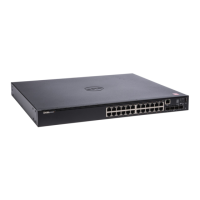Switch Management Commands 2241
• interval—The timeout period. If a response is not received within this
period of time, then traceroute considers that probe a failure (printing
*) and sends the next probe. If traceroute does receive a response to a
probe, then it sends the next probe immediately. (Range: 1–60 seconds).
• count—The number of probes to be sent at each TTL level (Range:1–
10).
• port—The destination UDP port of the probe. This should be an
unused port on the remote destination system (Range: 1–65535).
• size—The size, in bytes, of the payload of the Echo Requests sent
(Range: 0–39936 bytes).
• src-ip-address—The IPv4 source address to use in the ICMP echo
request packets.
• vlan-id—A valid VLAN interface.
• loopback-id—A configured loopback ID
Default Configuration
The default count is 3 probes.
The default interval is 3 seconds.
The default size is 0 data bytes.
The default port is 33434.
The default initTtl is 1 hop.
The default maxTtl is 30 hops.
The default maxFail is 5 probes.
Command Mode
User Exec mode and Privileged Exec mode
User Guidelines
Use of the optional VRF parameter executes the command within the
context of the VRF-specific routing table.
Traceroute operates by sending a sequence of Internet Control Message
Protocol (ICMP) echo request packets. The time-to-live (TTL) value, is used
in determining the intermediate routers through which the packet flows

